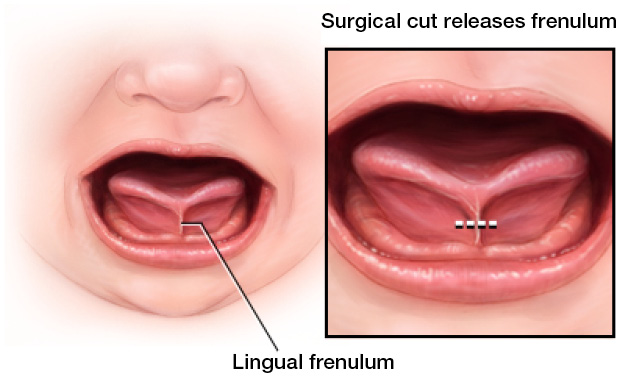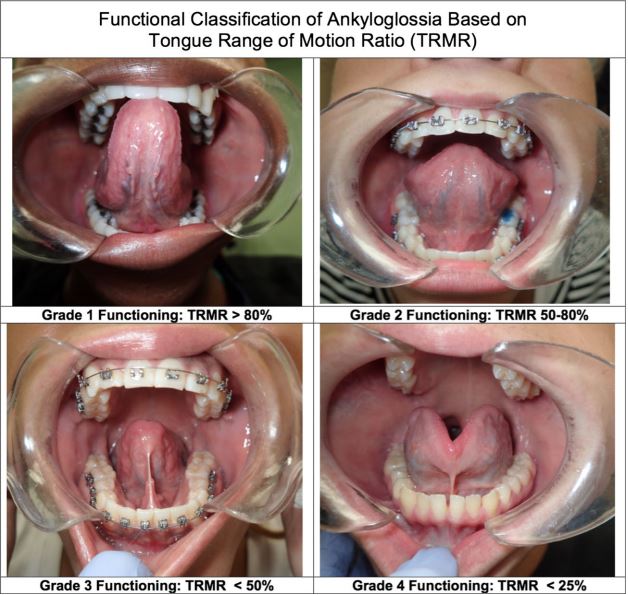Tongue tie is a condition where a short, tight band of tissue tethers the tongue’s tip to the floor of the mouth. It can affect feeding, speech, and oral hygiene.
Tongue tie, medically known as ankyloglossia, is often spotted at birth or early childhood. This congenital issue may lead to difficulties with breastfeeding in infants, and as children grow, it can potentially cause challenges with speech articulation and dental problems.
Early diagnosis and intervention can significantly improve quality of life by addressing feeding problems and preventing speech difficulties. Treatment typically involves a simple procedure called a frenotomy, which is a minor surgery where the restrictive lingual frenulum is snipped to free the tongue’s movement. Providing relevant information on symptoms, diagnosis, and treatment options is essential for parents looking to understand and manage tongue tie effectively.

Credit: www.mayoclinichealthsystem.org
Understanding Tongue Tie
Do you know that a small strip of skin under your tongue can make a big difference in how you eat and speak? Let’s dive into the world of tongue ties, a common condition that may affect both children and adults. Our journey through ‘Understanding Tongue Tie’ offers insights into what it is, its anatomy, and the different types it comes in.
Definition And Overview
A tongue tie, medically known as ankyloglossia, is when the strip of skin under the tongue, the lingual frenulum, is shorter than usual. This may limit the tongue’s range of movement. tongue tie can influence feeding in infants and speech in older children and adults.
Anatomy Of The Tongue And Frenulum
The tongue is a flexible muscle that helps in eating, swallowing, and talking. The frenulum is a tissue that connects the bottom of the tongue to the floor of the mouth. A closer look at this anatomy reveals the importance of how they work together.
- Tip of the tongue: Helps make sounds like ‘t’ and ‘d’.
- Base of the tongue: Anchors it to the mouth.
- Frenulum: Should be stretchy for free tongue movement.
Types Of Tongue Tie
Not all tongue ties are the same. There are several types, each affecting tongue mobility in different ways:
- Class I: Very front of the tongue, noticeable restriction.
- Class II: Slightly further back, less visible but can still restrict movement.
- Class III: Middle of the tongue’s under-surface, a moderate form.
- Class IV: At the base of the tongue, often hard to see.
Causes And Risk Factors
Tongue Tie is a peculiar condition that affects newborns. The medical term for it is ‘ankyloglossia’. Understanding its causes and risk factors helps parents and health professionals prevent or manage this condition effectively.
Genetic Predisposition
Family history plays a pivotal role in the likelihood of a tongue tie. Genetic traits pass down through generations, increasing the risk. If parents or siblings had tongue tie, infants are at a higher chance of developing the condition.
In Utero Development Factors
Tongue tie originates from the development in the womb. As the baby forms, the lingual frenulum, which is the tissue beneath the tongue, may fail to separate properly. This results in a restrictively attached tongue at birth.
Other Contributing Factors
- Hormonal influences during pregnancy may affect the lingual frenulum.
- Nutrition during pregnancy could contribute to a baby’s oral structure.
- Environmental factors like exposure to harmful substances may also impact.
Signs And Symptoms Of Tongue Tie
Tongue tie may affect how a baby eats and speaks. Knowing the signs is crucial. Early detection can mean quick action to help. Look for these symptoms ranging from infancy to adulthood.
Symptoms In Infants
- Difficulty latching during breastfeeding.
- Poor weight gain or slow growth.
- Fussiness when feeding.
- Milk spilling from the mouth.
- Gumming or chewing on the nipple.
Symptoms In Older Children And Adults
- Speech issues, like trouble with ‘t’, ‘d’, ‘z’, ‘s’, ‘th’, ‘r’, and ‘l’ sounds.
- Difficulty with oral hygiene due to less mobility.
- Challenges with solid foods, especially meats and apples.
- Feeling of a tight, pulled sensation in the tongue.
Impact On Breastfeeding
Breastfeeding troubles due to tongue tie can affect both mother and baby. Some challenges include:
| Mother’s Symptoms | Baby’s Symptoms |
|---|---|
| Painful nursing | Difficulty staying on the nipple |
| Cracked or sore nipples | Excessive hunger |
| Low milk supply | Colic or excessive fussiness |
| Upper back and neck pain | Gas or reflux |
Diagnosis Of Tongue Tie
Diagnosing tongue tie, a condition medically known as ankyloglossia, involves a careful look at the tongue’s mobility and attachment. It’s more than just a physical barrier; it can affect feeding in babies and speech development in children. Understanding the diagnosis can guide effective treatment and support.
Physical Examination
The first step in diagnosing tongue tie is a physical examination. A healthcare professional will look at the tongue’s appearance and range of motion. They will check for the distinctive ‘heart’ shape the tongue makes when trying to extend past the lower lip. During this exam, they may also look for difficulties in breast or bottle feeding, which can indicate a tongue tie in infants.
Assessment Tools And Scales
Clinicians may use specific assessment tools and scales to evaluate the severity of the tongue tie. These include the Hazelbaker Assessment Tool for Lingual Frenulum Function (HATLFF) and the Bristol Tongue Assessment Tool (BTAT). By scoring various aspects of tongue function and appearance, these tools help determine the need for intervention.
| Assessment Tool | Function Evaluated | Usage |
|---|---|---|
| HATLFF | Appearance & mobility | Breastfeeding infants |
| BTAT | Mobility & speech | Older children |
When To Seek Medical Advice
Seek medical advice if you notice feeding problems, speech difficulties, or poor weight gain in your child. If your baby seems unable to latch properly or is fussy at the breast, it might be time to consult a lactation expert or pediatrician. A quick intervention can make a significant impact on your child’s development and comfort.
- Bottle feeding takes unusually long
- Breastfeeding is painful or ineffective
- Speech impediments in older children
- Difficulty moving the tongue
Complications And Long-term Effects
Understanding the complications and long-term effects of tongue tie is vital for parents and caregivers. This condition can significantly affect a child’s development and daily life if left untreated. Below, we dive into the most common issues that may arise over time.
Speech Development
Tongue tie restricts tongue movement, making it tough for kids to pronounce certain sounds. This can lead to:
- Delayed speech, as kids struggle to form words.
- Unclear speech where listeners find it hard to understand the child.
- Speech therapy needs which may be required to correct these issues.
Dental And Oral Health Issues
Poor tongue mobility can interfere with oral hygiene and dental development. Issues include:
| Issue | Outcome |
|---|---|
| Gaps between teeth | Can lead to misalignment and bite problems. |
| Difficulty brushing | Higher risk of cavities and gum disease. |
| Tongue thrusting | May cause orthodontic issues over time. |
Social And Psychological Impact
Tongue tie can take a toll on social interactions and self-esteem. Notable impacts:
- Frustration in social settings due to speech difficulty.
- Embarrassment when eating or speaking in public.
- Feeling different may affect friendships and participation.

Credit: tonguetieal.com
Treatment Options For Tongue Tie
Ankyloglossia, commonly known as tongue tie, may affect speech, feeding, and oral development. Understanding treatment options empowers patients and parents to make informed decisions. Two primary surgical methods can alleviate the condition: frenotomy and frenuloplasty.
Frenotomy And Frenuloplasty
A frenotomy is a quick procedure, typically without anesthesia, to release the tongue’s restricted movement. A doctor snips the frenulum, offering immediate improvement. Frenuloplasty, on the other hand, is more complex. It requires general anesthesia and sutures to reshape the frenulum for optimal results. Both interventions offer solutions for tongue tie, with the choice depending on the severity of the condition.
Laser Surgery Advantages
- Precise and Less Bleeding: Laser targets the area with minimal impact on surrounding tissues.
- Reduced Pain: Laser surgery often results in less postoperative discomfort.
- Faster Healing: The laser promotes quicker tissue repair and recovery.
- Lower Infection Risk: The laser’s heat sterilizes the wound, diminishing infection chances.
Post-surgery Recovery And Care
Post-surgery, the focus is on healing and preventing complications. Adherence to a care plan ensures the best outcome.
- Follow professional guidance for pain management and wound care.
- Perform suggested tongue exercises to promote flexibility and healing.
- Maintain a soft food diet initially to minimize discomfort.
- Attend follow-up appointments to track recovery progress.
Alternatives To Surgery
When considering tongue tie, surgery isn’t the only option. This section explores effective, less-invasive alternatives. These may provide comfort and improve tongue function without the need for surgery.
Speech And Feeding Therapy
These therapies often help children and adults with tongue tie. A speech-language pathologist can work on speech issues. An occupational or feeding therapist can help with eating difficulties.
- Speech exercises improve pronunciation and articulation.
- Feeding techniques assist in teaching proper chewing and swallowing.
Exercises And Stretches For Tongue Mobility
Daily exercises can increase tongue strength and flexibility. These activities are simple and can be done anywhere.
| Exercise | Description | Frequency |
|---|---|---|
| Tongue lift | Lift the tongue to touch the roof of the mouth. | 10 reps, 3 times a day |
| Tongue extension | Stick the tongue out as far as possible. | 10 reps, 3 times a day |
Monitoring And Conservative Management
Some cases of tongue tie improve with time. Close observation may be recommended. Here are key points to monitor:
- Check tongue movement regularly.
- Watch for signs of speech or eating problems.
- Regular visits with a healthcare professional.
Living With Tongue Tie
Living with Tongue Tie presents unique challenges for individuals and their caregivers. It affects daily functions many take for granted, from eating to speaking. Yet, with the right adjustments and support, quality of life can significantly improve.
Adapting Feeding Techniques
A Tongue Tie can make feeding difficult, especially for infants. Parents often need to modify how they feed their child to ensure they receive adequate nutrition.
- Use specialized bottles designed for a better latch.
- Adjust nursing positions to find the most comfortable one for the baby.
- Work with a lactation consultant for personalized tips.
Communication And Speech Development
Speech clarity can be a hurdle with Tongue Tie. Early intervention with a speech therapist can set the groundwork for clearer communication.
- Regular speech therapy sessions focus on articulation exercises.
- Practice specific sounds that are challenging due to Tongue Tie.
- Encourage plenty of verbal interaction at home.
Psychosocial Considerations
Awareness of emotional and social impacts is vital for those living with Tongue Tie. Support from family, friends, and professionals can foster resilience and self-esteem.
- Educate peers and teachers to promote understanding.
- Participate in support groups for shared experiences.
- Focus on strengths rather than limitations.
Emerging Research And Developments
The study of tongue tie, known as ankyloglossia, has seen exciting advancements in recent years. New research is shedding light on improved medical approaches, long-term effects, and genetic factors. These developments promise better outcomes for those affected. Let’s dive into some of these pioneering findings.
Advancements In Surgical Techniques
New techniques are revolutionizing tongue tie surgery. Surgeons now use tools that cause less pain and speed up recovery. These include:
- Laser technology for precise cuts
- High-frequency energy devices for minimal bleeding
- 3D imaging for accurate assessments pre-surgery
These advancements mean safer procedures and happier patients.
Studies On Long-term Outcomes
Researchers have begun to closely observe how patients with tongue tie fare over time. Results so far suggest that:
- Early treatment may lead to better speech development
- Quality of life can greatly improve following surgery
- Feeding difficulties often decrease post-procedure
Such studies underscore the importance of addressing tongue tie early.
New Insights Into Genetics And Prevention
Geneticists are uncovering links between tongue tie and family history. Their findings show:
- Specific genes may increase the risk of developing tongue tie
- Prenatal factors play a critical role in prevention
- Screening for tongue tie could become standard for newborns
This knowledge paves the way for pre-emptive action against tongue tie.

Credit: www.enttoday.org
Conclusion
Understanding tongue tie is crucial for early detection and treatment. Remember, it can affect speech, eating, and dental health. Seeking advice from health professionals ensures the best care. Support children’s development by staying informed. Embrace a proactive approach for a healthy, thriving future.

